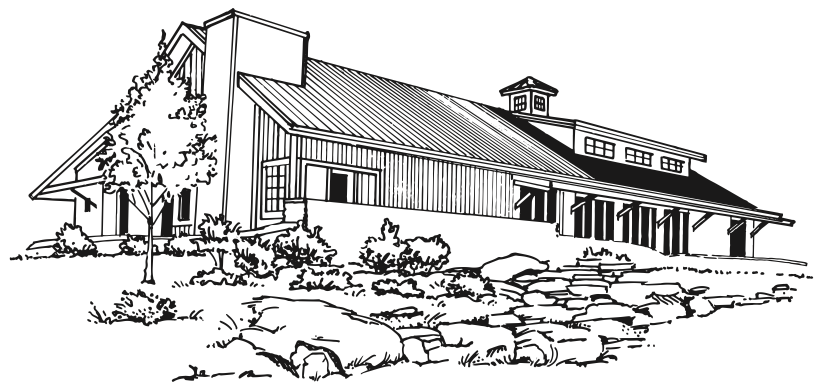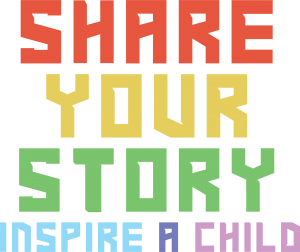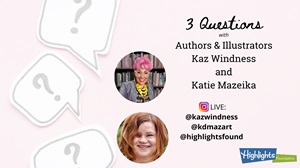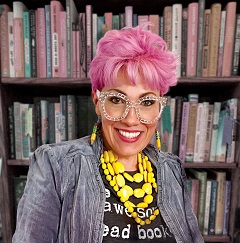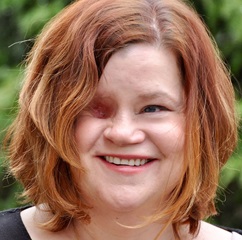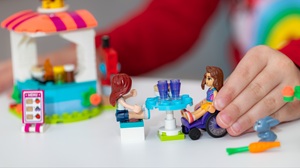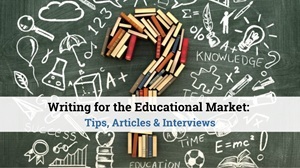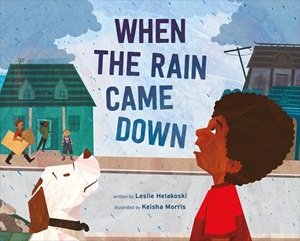Kaz Windness and Katie Mazeika joined Highlights Foundation Social Media Manager Cat Galeano on Instagram Live to talk about disability representation in picture book illustration
Watch the conversation below. (Please note: closed captions are being added to the video below. When they are finished, you can see them by hovering over the bottom of the video and choosing the “CC” icon.)
Full Transcript:
Cat:
I am so excited to welcome you both with me for this IG live. Katie has brought a plushy for support so I feel extra happy because we always need a plushy. You know what I feel like I should have an emotional plushy sitting with me when I do these.
Um,thank you both for being here with me. I really appreciate it. So basically how today’s going to go: I’m going to do a small intro. We’re going to go through our questions. I’m going to give you time to add anything you’d like to add. And then, of course, we’ll do an outro and it should be around 15 minutes, OK.
Important question before we start. What is the plushy’s name?
Kaz:
This is Hopper.
Cat:
Hopper! Thank you, Hopper, for also being here with us. We already feel extra, extra love and more wonderful simply by having a companion with us.
So I’m going to get started, and a big hello to our Highlights Foundation family. We’re so happy to have you here with us. For those that may not know me, I’m Cat Galeano, my pronouns are she/her. I am the Social Media Manager for the Highlights Foundation, joining you from Westchester, New York on the traditional lands of the Seewanoy people. Apart from all the fun things I get to do at the Highlights Foundation, I am also a reader and a writer who is very excited to welcome our friends and faculty Kaz Windness and Katie Mazeika, who will be co-teaching Disability Representation in Picture Book Illustration: A Two-Night Mini on May 7th and May 9th online.
But before we dive in, I, I just want to remind our viewers that joining in on any Highlights Foundation sessions, to do so with no hate, no harm and no harassment of any kind.
And now let’s get started. So my first question, which of course decided to leave my screen, right as we were about to ask it. So: technical difficulties, let me let me find it. It’s and I, it’s.
Kaz:
I have them up too, if you need me?
Cat:
That would be wonderful, because of course everything decided to NOT work. Um, hold on. Hopefully. Uh, yes, if you don’t mind, if you don’t mind because I got locked out of my e-mail and everything right now. So….so I’m just like GREAT. So love that for me. Wait, I think I have them right here.
Sorry about tha,t friends. Usually I’m so prepared, but of course, today, of course you know, everything decided to, to, to be a little slower. OK, here or there, here they are. Sorry about that. Got locked out of my e-mail. It flew out of my; I mean, literally everything that could have happened. So sorry, we’re ready, we’re back to go.
So this topic that we will be discussing for this Mini is very important, especially with the focus on illustration, because diverse representation in children’s books also includes differences in bodies’ abilities and the way that that people process the world. So I first wanted to start with: what’s an example of a book that was memorable for you because of how it accomplished this? It could either be from childhood or a more recent title.
Kaz:
Katie, do you want to go first?
Katie:
Um, sure. The one I remember loving is a kid was Madeline. And Madeleine; I, I I lost my eye when I was 3. I was in and out of hospitals all the way pretty much through through early elementary school. Madeline was the only book out there when I was a kid that showed the hospital that art showed Madeline showing off her scar. That was a big deal to me. But, but, hospitals were a taboo. And you know, in children’s publishing for a long time. Today, I love, I love El Deafo. I think El Deafo is beautifully done and it just, it deals with disability from a kid’s point of view, wonderfully.
Kaz:
Beautiful. I, I wanted to bring up a new book. This is called Flap Your Hands: A Celebration of Stimming. And this is my friend Steve Asbell. And this is told from the autistic perspective. But all people stim, and this de stigmatizes stimming in such a beautiful way. It, it talks about, it shows the overwhelm that we can have when they’re, the world is too loud or it’s just difficult to deal with things in our environment. And then he brings in these beautiful, gorgeous illustrations that talk about different ways that we can stim. And some of these I hadn’t tried myself and it was really fun to experiment with them as I was reading through the book and I just think he does such a beautiful job and also I, I don’t see echolalia represented very often in books and that’s certain; I mean the way I get through a grocery store is I’m like um, “organic, organic, organic…” you’re saying whatever word it is over and over and over, to comfort me. And so this is a beautiful new book, so thanks for asking. That’s always a great question: What are you reading?
Cat:
I just want to make sure our audience knows that we will have a transcript of this conversation so those names of those titles will be included because I know that we just sort of talked, talked them out and flash them quickly. So just want to make sure that the names and authors and illustrations, illustrators will be mentioned in the transcript and we’ll have all that information for you because those three titles. Definitely Madeline, of course, I grew up with as well, but I have not read El Deafo and I have not seen that new one, so definitely, definitely gonna add it to my list. Thank you for sharing. That was so beautiful and I really, really loved hearing your favorites and, and what stuck out to you. So my second question is: what’s an example from your own work and what specifically were you, what were you hoping your readers would take away from it?
Kaz:
You want to go first, Katie?
Kate:
You could so first this time.
Kaz:
OK. So you’ve probably know Bitsy Bat,School Star and this is my book that’s told from the autistic perspective but it does celebrate every child’s difference, which is really important to me. Also in this book I just wanted I, you know, a lot of times they want the book to be inspirational and show what the child does FOR the community that makes them special and included. I did not want ihis book to be presented that way. I wanted Betsy to be accepted for her differences and accommodations made for her differences and for her to be loved because she deserves love. So this talks about Bitsy going to school for the first time and being in a classroom full of nocturnal animals who don’t hang upside down like she does. They don’t have the same kind of sensory issues that she does. And so she tries to fit in. I’m a big masking autistic and you know she tries to do that at great consequences to herself. But then she thinks of a way where she can celebrate her differences and also invite other students to talk about what makes them special. And I have included things in this book that show like her chair is adapted so she can be at the table with the other kids at the correct orientation. And I also have included other examples of disability in this book, but I’ve had so many parents and kids come up to me and say “this is the first time I’ve ever seen someone wearing headphones in the classroom” and normalizing that because I wear headphones. So normalizing that and also before–this is something Katie and I were talking about–you know, before people get the negative stereotypes, before they get those biases, if we can let them see examples of what it is to be inclusive before they get those in their head, it’s so much easier to deal with, get, get in front of it. So we’re not dealing with, like, undoing all these stereotypes and negative ideas of of what disabled people are like so…
Cat:
That was so powerful, thank you.
Katie:
Alright, I, I have two picture book biographies. One, Annette Feels Free was about Annette Kellerman and it dealt with disability. Beulah Has a Hunch! was about Beulah Louise Henry. And that was, she felt, touched on neurodiversity, and as much as I love these both, the one that I really think does the, says what I want it to is the one I have upcoming, called So Maybe Just Ask Me and that’s out in the spring and that one is where I really talk about de-stigmatizing disability and asking outright and instead of focusing on not looking, which is something we tell kids: don’t stare. Don’t ask. Pretend you don’t see. Instead, we need to teach our kids it’s OK to ask; if you’re asking through kindness it’s always OK, just as long as they understand it’s also OK for people to say no, I don’t want to tell you. I don’t want to talk about it.
Kaz:
Yeah, kindness is always the answer. I love that so much.
Katie:
Exactly. And in, I think, I know I was taught to look away and not, not pay attention. I think that’s common, but I think that was, that’s just not, I think at this point when you teach people to, to look away from disabled, you know, disabled people, you’re “othering” them. And you’re teaching kids that there’s something to be afraid of or something wrong. And that needs to be undone. We need to stop thinking that way.
Cat:
That needs to be undone. And us, who are already grown and need to learn to remember that kindness and that it’s OK to ask because we are already ingrained with that: don’t look, don’t ask. Don’t do anything so…kindness, like lead with kindness. It’s OK to ask and, Katie, like you said, if the person doesn’t want to answer, you came from a place of love and kindness. It’s OK that there’s no answer and it’s like, OK. Understood. Moving on.
Katie:
Yes, we need to, you know, the first thing I say when it’s a school visit is, is who wants to ask me? Yeah, they’re all…like it’s OK. I know, yeah. But you know, it’s kids are naturally curious and I think to act like they aren’t is, is, you know, it’s foolish. It’s not going to work.
Kaz:
Yeah. Well, and I’m confronting my own internalized ableism all the time. And so like having these safe places and what Highlights is providing for people to say: Is this OK? How am I doing this? Because I, I think we are so afraid of getting it wrong that we aren’t talking about it at all. We aren’t putting it in our books and we need to put it in our books. So this this whole workshop is is providing a safe place to ask this question and also to cover the, the main things that maybe you haven’t thought of. All I’ve, I’ve already learned so much by talking to Katie and what she has prepared so far. And so we’re just really excited for that.
Katie:
Thank you, Kaz. I appreciate that, but I gotta say your, your, your own fount of knowledge, your representation is beautiful.
Kaz:
Mutual admiration society.
Cat:
So, basically what we’re trying to say here is that you better come because this is going to be a love fest and, and a very informational fest, yeah. So please come you know, illustrators, writers, author-illustrators, everyone, I, we encourage you to come because there is a lot to learn and I get the sense that these two people, wonderful people, know a lot, uh, and they’re going to share a lot. So I hope you consider joining us. So my third and final question is: what do you hope that people will leave this course in their journey to inspire kids through story?
Katie:
Can I go first? Yeah, yeah, alright. Illustrators have more power than we realize. Before kids can even read, they’re seeing our pictures. So we need to use that power, make sure and, and Kaz touched on this, that we’re not using disabled tropes, disability tropes, and that we are representing not just the kids who need to see themselves in the books. Not just for them, but for everybody, we’re representing disability the right way.
Kaz:
Yes. Oh, I, I couldn’t have said that better. And the other thing I’d like to bring into; I love how, Katie, we were talking about this yesterday and she said “I bring the facts and you bring the fun.” Fun too and really inspiring to me that you know it’s showing accessibility. It, you, it adds so much flavor to lik,e you know, a way a child represents them, themselves and to not just fall back on the the symbols that we just kind of have in our mind. We gotta throw in a wheelchair. Don’t, you, they’re pecific to the person that’s using them. So let’s think about that design piece and also like: it can be fun!
Katie:
Absolutely. Absolutely.
Cat:
So I want to kind of leave the floor to the both of you ifyou’d like to add anything before our course, which launches on May 7th, I believe. So if you’d like to add anything please go ahead and share.
Katie:
We are offering an opportunity to have a image reviewed.
Kaz:
Yes, I was just going to say that, the same thing.
Katie:
I’m sorry, Kaz.
Kaz:
A mind-meld. Yeah, so we we are offering for the second night for people that sign up, you know, by April 30th, so it is coming up quickly. We are going to consider illustrations that you submit. There’s just a form that comes with that sign-up. So you can submit an illustration and we’re going to have a very safe and fun place to take a look at those illustrations to offer some suggestions. I already see some great images I’m so excited to talk about. So you know this is an added opportunity to not just get our information but also get personalized information. I think it’s so helpful to see like works in progress. And because you want to get it right and get it better before you’re putting in front of an editor or an agent or something like this? Like it’s the perfect opportunity to get, you know, our help before you go out with it. And we’re just here to, like, celebrate you and lift your voices and help you have more opportunities to share those very important stories. So I do hope you join us.
Katie:
Absolutely. Um, and like Cass said, it’s safe space. We’re going to have open discussions, talk about why we’re seeing some things and why we’re not seeing others and just how to do it best. And um, yeah.
Kaz:
Yeah.
Cat:
So make sure you register because that, that link where you can upload your your art and your illustration will be included. So that is so generous of our faculty. Thank you so much for for adding that bonus for the class. And I think it’s going to be really special, to be able to do that in real time and LIVE. Yeah. Yeah. And so thank you. Thank you. Thank you. And, and people if you signed up already the link I’m sure will be coming your way. And for those that haven’t yet, please do. The link will be provided so that you can upload and again you have until April 30th for this special bonus and again, and again not all pieces will be looked at. I just want to make that clear, because of course we are under time constraint so. Please share but again understand if Katie and Kaz don’t get to it, it’s nothing personal. It was just time. And yeah, that is it for me. Let me just share my, again my, my script just decided to just fly around, yes. Thank goodness we had our friend Hopper today because I truly needed Hopper today.
Oh yeah, my, my, OK, here we go. And if you’d like to learn more from Katie and Kaz, please join them on May 7th and 9th for Disability Representation in Picture Book Illustration: A Two-Night Mini. You can register on our website highlightsfoundation.org and lastly you can purchase Katie and Kaz’s books on our virtual bookshelf powered by bookshop.org. Thank you, Katie. Thank you, Kaz. Thank you, Hopper, for joining us today and we can’t wait to see you online. Thank you friends.
Kaz:
Bye.
Cat:
Bye everyone. Thank you for joining.
Katie:
Bye.
